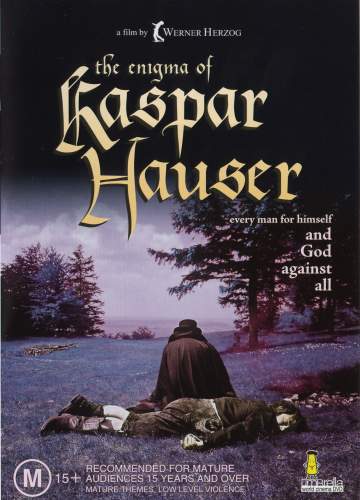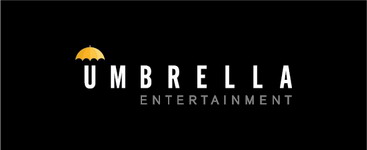The Enigma of Kaspar Hauser (Jeder für Sich und Gott Gegen Alle) (1974) |
|
The Enigma of Kaspar Hauser (Jeder für Sich und Gott Gegen Alle) (1974) |
|


|
| BUY IT |
| General | Extras | ||
| Category | Drama |
Main Menu Audio Audio Commentary-Werner Herzog (Director) And Norman Hill (Journalist) Biographies-Crew-Werner Herzog Theatrical Trailer Trailer-Herzog Collection |
|
| Rating |

|
||
| Year Of Production | 1974 | ||
| Running Time | 109:35 | ||
| RSDL / Flipper | RSDL (73:53) | Cast & Crew | |
| Start Up | Menu | ||
| Region Coding | 1,2,3,4,5,6 | Directed By | Werner Herzog |
|
Studio
Distributor |
 Umbrella Entertainment |
Starring |
Bruno S. Walter Ladengast Brigitte Mira Willy Semmelrogge Michael Kroecher Hans Musaeus Marcus Weller Gloria Doer Volker Prechtel Herbert Achternbusch Wolfgang Bauer Wilhelm Bayer Franz Brumbach |
| Case | Amaray-Transparent-Secure Clip | ||
| RPI | $29.95 | Music | Florian Fricke |
| Video | Audio | ||
| Pan & Scan/Full Frame | None |
German Dolby Digital 2.0 (192Kb/s) English Audio Commentary Dolby Digital 2.0 (192Kb/s) |
|
| Widescreen Aspect Ratio | 1.75:1 | ||
| 16x9 Enhancement |
 |
||
| Video Format | 576i (PAL) | ||
| Original Aspect Ratio | 1.85:1 | Miscellaneous | |
| Jacket Pictures | Yes | ||
| Subtitles | English | Smoking | No |
| Annoying Product Placement | No | ||
| Action In or After Credits | No | ||
In 1828 a man was found standing in the town square of Nuremberg holding a letter to the local army captain in his hand. He was barely able to speak or even walk. Assumed to be an idiot, when given a pencil and a piece of paper he wrote "Kaspar Hauser". Over the next 5 years attempts were made to teach him to fit into society, He learned to talk and with the assistance of a professor made an attempt at writing his own history. Hauser's origins were never discovered, but he was rumoured to be the illegitimate son of royalty. What is known is that he seems to have spent his early life up until the time he was found in the Nuremberg square in a tiny cell, and had little human contact.
Nearly one hundred and fifty years later Werner Herzog took this true story and fashioned a strange film out of it. Like many European movies of the 1970s it unfolds in its own time and fashion, seemingly without any narrative impetus in the accepted sense. It appears to be merely observational, documentary-like and lacking in viewpoint. But in fact it is a film that makes some points about the social and linguistic reality which we accept as factual, and questions what it is about our lives that is socialised and what is natural.
Herzog is aided in this endeavour by an amazing performance by Bruno S. His story has parallels to that of Kaspar Hauser. Bruno was the son of a prostitute who beat him severely then at the age of three had him put into homes for the mentally disabled for most of the next twenty years. While he was not actually mentally disabled, this treatment and his experience left him severely scarred. Herzog saw him in a documentary and cast him in the role, but had terrible trouble dealing with him on the set. It was worth the effort, because Bruno looks not to be acting most of the time. In fact he is stunningly convincing, looking in the early scenes as if he was genuinely retarded, which captures the innocence of Kaspar perfectly.
The rest of the cast was unfamiliar to me apart from Fassbinder regular Brigitte Mira as the professor's wife. Appearing in the credits were the names of Reinhard Hauff, himself a prominent director of the 1970s, and Enno Patalas, a film historian who would be familiar to purchasers of the Region 4 Metropolis DVD on which he provided the audio commentary.
Deserving of special mention is the production design. The film takes place in what looks like a genuine town of the era, and which is one which has survived more or less intact to the present day. There are no anachronisms and one really feels as though the settings are authentic.
This is a fascinating film and one well worthy of a screening. The original German title translates as Every Man For Himself and God Against All, not perhaps a title that would have performed well in some countries.
The film is presented in an aspect ratio of 1.75:1 and is 16x9 enhanced.
From the opening scenes on a fog-bound lake you know that this is not going to be a perfect transfer. This scenes shows terrible MPEG artefacting and lots of grain and noise. Fortunately this is the worst that things get, and the rest of the film is much better handled. However there is significant grain throughout.
The image is sharp enough but there is a lack of detail. The closest analogy I could apply would be to say that it looks like a blown-up VHS copy with added sharpness, though I doubt that it is from a VHS master. I think that the original picture quality is partly to blame.
The transfer is reasonably bright and contrast is also within acceptable limits. Shadow detail is a little below average. Colour seems lacking in saturation but seems to me to be consistent with the period feel of the picture.
Apart from the MPEG artefacting noted above there is some edge enhancement, which is noticeable pretty much throughout. There is some evidence of excessive noise reduction at 17:49. Telecine wobble is an issue, with the film looking shaky at times. There are few film artefacts, with occasional faint scratches and flecks.
The optional English subtitles are in a yellow font and contain American spelling. There are a few lines of dialogue that are not translated, but you can work out what is being said. The subtitles are clear and easy to read.
The disc is RSDL-formatted with the layer change well placed at 73:53.
| Sharpness | |
| Shadow Detail | |
| Colour | |
| Grain/Pixelization | |
| Film-To-Video Artefacts | |
| Film Artefacts | |
| Overall |
The main audio is German Dolby Digital 2.0, which appears to be mono. I did not notice any stereo effects and there is definitely no surround encoding.
The audio is acceptable for a mono soundtrack of this vintage. At times it is a little distorted, but most of the time it is clear and without any noticeable hiss. Dialogue seems to be clear and there are no audio sync issues.
The music is mostly snippets of works from the period, and is often used to link scenes rather than to bolster the drama.
| Dialogue | |
| Audio Sync | |
| Clicks/Pops/Dropouts | |
| Surround Channel Use | |
| Subwoofer | |
| Overall |
Pachelbel's Canon, which is the opening music of the film, is heard with the main menu.
The audio commentary features Werner Herzog and Norman Hill, the latter simply prodding the director with questions when the pace slackens. Herzog has a detailed recollection of the production, including details such as where and why individual shots were made, who the actors were (including a few cameos by friends), and also which parts of the story are based on fact and which were invented for cinematic reasons. This is a valuable commentary and well worth a listen.
A single page of biographical information about the director.
An original trailer for the film.
Trailers for four of the five films in the Herzog/Kinski set.
NOTE: To view non-R4 releases, your equipment needs to be multi-zone compatible and usually also NTSC compatible.
The US Region 1 release comes from Anchor Bay. The contents of the disc are quite similar to the Region 4, with the same audio commentary and the trailer. The Region 4 misses out on the text biography of Herzog. Reviews of the video quality indicate that it is about the same as the Region 4.
A fine film told in a different style to most film biographies.
The video quality is average.
The audio quality is satisfactory.
An excellent audio commentary and some middling additional extras.
| Video | |
| Audio | |
| Extras | |
| Plot | |
| Overall |
| Review Equipment | |
| DVD | Pioneer DV-S733A, using Component output |
| Display | Sony 86CM Trinitron Wega KVHR36M31. Calibrated with Ultimate DVD Platinum. This display device is 16x9 capable. |
| Audio Decoder | Built in to DVD player, Dolby Digital, dts and DVD-Audio. Calibrated with Ultimate DVD Platinum. |
| Amplification | Sony TA-DA9000ES |
| Speakers | Main: Tannoy Revolution R3; Centre: Tannoy Sensys DCC; Rear: Richter Harlequin; Subwoofer: JBL SUB175 |